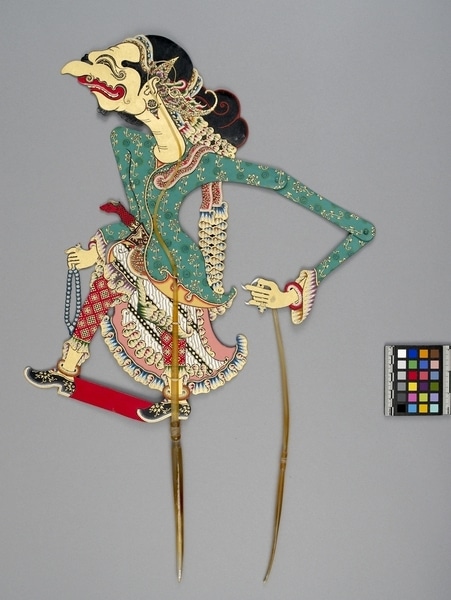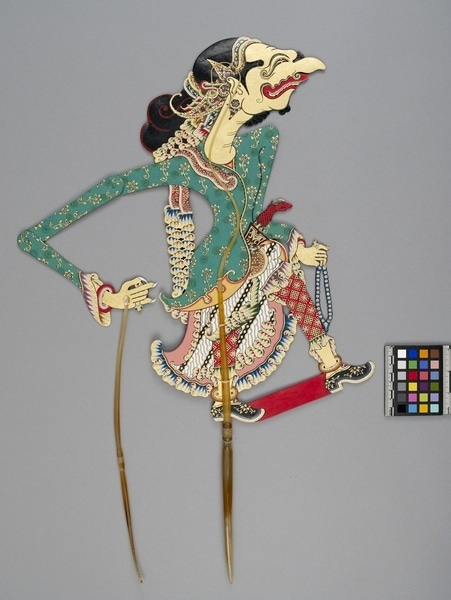Shadow Puppet Item Number: 1374/27 from the MOA: University of British Columbia


Description
Shadow puppet (wayang kulit) representing the character Durna. Two-dimensional figure of a man with one arm articulated at the shoulder and elbow; other arm is at his side. Man is wearing regalia shirt, skirt, pants, shoes, headdress, sword, and jewelry. The shirt is green with gold floral decorations; the skirt is in blues, greens, pink, white, and purples; pants are red with gold, diamond-shaped checkered designs; headdress is in same colours as skirt and goes from forehead down to shoulders; shawl goes over shoulder and down back to below waist; sword has animal head-shaped hilt and is in a black and gold scabbard; jewelry is one band at each ankle and wrist, one ring on each hand, a beaded necklace being held in stationary hand, and earrings; shoes are black with gold floral decoration and they resemble clogs. Articulated arm is controlled by a long horn rod that is attached to the hand; a second horn rod has been split down centre for most of its length and has the height of the set into it.
History Of Use
Wayang kulit shadow play is over a thousand years old. It is thought to be derived from the leather shadow puppetry of southern India, like tholu bommalata, which came to Java with the spread of Hinduism in the first millennium. In Java--part of the largely Islamic Republic of Indonesia--this highly distinctive form of shadow puppetry is valued as a pusaka, a sacred treasure of the royal court of Yogyakarta. The plays are performed to mark special occasions, such as birthdays, marriages, and religious events. They have also been adapted for television and for public education campaigns. At the heart of all performances is the dhalang, the leading artist, puppeteer and gamelan orchestra leader. With immense energy, drama, humour and creativity, the dhalang is responsible for manipulating the puppets; for interpreting their personalities and gestures; for speaking in their particular voices; for narrating the story and for conducting the gamelan orchestra— gongs, xylophones, drums, bowls, vocals, strings. When the play is about to begin, the dhalang places one of his gunungan or kayon—a large leaf-shaped shadow puppet-form representing a tree of life or sacred mountain—in the centre of the screen to separate the opposing groups of puppets and to announce that the cosmic order is in balance. Part way through the play, chaos descends when the four clown characters--Semar and his sons, Bagong, Gareng and Petruk--make an entry. They enliven and delight the audience with their crude and comic behaviours, jokes and songs.
Item History
- Made by Pak Sagio (Maker) in Yogyakarta, Java, Indonesia before September 1989
- Collected by Dominique Major
- Owned by Dominique Major before October 17, 1989
- Received from Dominique Major (Seller) and Museum of Anthropology Shop Volunteers (Funding source) on October 17, 1989
What
- Name
- Shadow Puppet
- Identification Number
- 1374/27
- Type of Item
- puppet
- Material
- water buffalo skin, paint, fibre and horn
- Overall
- height 64.0 cm, width 29.9 cm, depth 1.4 cm
Who
- Culture
- Javanese
- Creator
- Pak Sagio (Maker)
- Field Collector
- Dominique Major
- Previous Owner
- Dominique Major
- Received from
- Dominique Major (Seller) and Museum of Anthropology Shop Volunteers (Funding source)
Where
- Holding Institution
- MOA: University of British Columbia
- Made in
- Yogyakarta, Java, Indonesia
When
- Creation Date
- before September 1989
- Ownership Date
- before October 17, 1989
- Acquisition Date
- on October 17, 1989
Other
- Condition
- excellent
- Accession Number
- 1374/0027